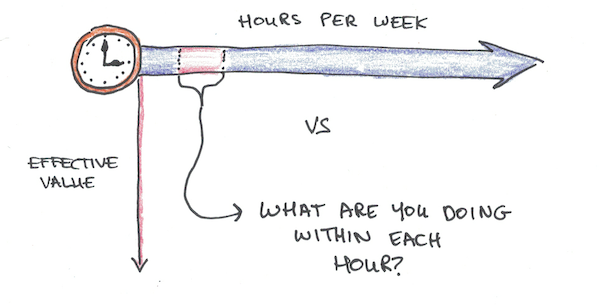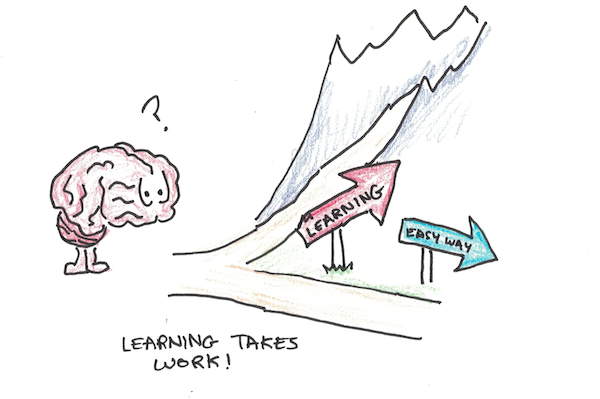
One of the biggest misconceptions about ultralearning is that it’s mostly about putting in a ton of hours towards a project in a short burst of time.
On the surface, I can see why this impression would be misleading. My own projects often involve a ton of hours towards a project in a short burst of time. Therefore, I can hardly be surprised when people think it’s intrinsic to the method I’m advocating.
But the truth is that you can be an ultralearner even if you only have a few hours per week you can devote to learning something new.
Aggressiveness ≠80-Hours per Week

I define ultralearning as aggressive, self-directed learning. This puts it in contrast with much of what we think about education. Schools, where you are told what to learn, how to learn it, and often don’t really know why, are the major difference.
However, typical self-education is also not ultralearning because it’s not aggressive. It’s playing on DuoLingo to learn a language, instead of something that actually works. Dabbling instead of really thinking hard about the right way to acquire skills.
The problem, however, is that when I say “aggressive” it often just looks like I’m saying “go do the same things you’re doing now, but do them eighty hours a week until your brain turns to jello.”
The truth is actually a lot more subtle.
What Separates Ultralearning from How Most People Learn
Throughout my book, I argue that there are principles of learning which exhibit a common pattern: something that is hard to do, requiring more mental effort or being a bit scarier or more frustrating, is nonetheless more effective for learning than something easy.
That this happens again and again in cognitive science could just be a coincidence. After all, it could have been that the easiest thing is always the best thing for learning and that avoiding frustration, difficulty and effort were the keys to learning well. That it doesn’t appear to be this way in reality is an interesting observation in and of itself.
There are some good examples of where a more difficult method works better than an attractive, easier option:
- Retrieval, where you try to recall things from memory, is harder than review, where you merely look at the information over and over. It’s also way more effective for later retention.
- Direct practice, where you learn by doing the thing you’re trying to learn, prevents problems of transfer, which often occur in the sterilized learning environment where skills are taught abstractly, without connection to real life. This is often more difficult because doing the real thing is often more frustrating and scary than textbook alternatives.
- Difficulty itself may be desirable in some contexts, where more difficult retrieval creates more durable memories (e.g. free recall vs cued recall).
Why it should be this way is an interesting question. One possibility is that sometimes the best learning method is the easiest and sometimes it is harder, somewhat at random. However, because we automatically gravitate towards the easiest things, I don’t need to tell you what to do when the easiest method actually is the best. Therefore, the only purpose of books like mine is to point out the places where a harder method is actually better.
Another possibility, which I take seriously, is that your brain always takes the path of least resistance. Learning is effortful and exhausting, and so when you can avoid learning, your brain will take that option, if possible. Effective learning tends to be harder, therefore, because it prevents you from taking the easier “not learning” path that your brain might take in isolation of more stringent constraints.

Why Ultralearning Needn’t Be a Full-Time Activity
Ultralearning, with its focus on aggressiveness, therefore is about seriously answering the question, “what activities should I do to learn this well?” Those activities are often more effortful than the default, but they are also more effective. This is what I’m trying to advocate in encouraging ultralearning—picking activities that actually let you learn and not filler ones that feel good but have no value.
However, it’s really important to stress, as I do in my book, that nowhere in my research did I find that doing these activities in an extremely concentrated burst is necessary.
In fact, the opposite finding, that spacing out learning over time leads to greater long-term retention, is a fairly well established one in the psychological literature. Therefore, long-term habit-driven ultralearning projects are often even more useful than short-term intensive ones.
I do think there are often some psychological benefits for intense, short-term projects if you can fit them in your schedule. The biggest one is that it’s easier to maintain motivation to do hard things for one month than four years. And because the activity of ultralearning is difficult, and often necessarily so, shorter projects often a little easier to execute.
Similarly, some types of learning activites, such as immersion, often benefit from an all-or-nothing behavior change, which lends itself for intense short-term projects. My Year Without English project would have been harder (although still doable) if I was only doing immersion for a few hours per week.
How You Should Approach Ultralearning in Your Own Life
The right way to think about ultralearning is at the level of what you’re actually doing while you learn. Whether those “ultralearning activites” take place over an intense, full-time project, or a leisurely, spread-out one, is just a matter of your schedule.
In any moment when learning, you have many options for choosing what to do to learn. Choose the activities wisely, and you can learn more effectively. Sometimes, when the default path is usually terrible, you can learn much faster than the status-quo, even if you’re not a genius.


 I'm a Wall Street Journal bestselling author, podcast host, computer programmer and an avid reader. Since 2006, I've published weekly essays on this website to help people like you learn and think better. My work has been featured in The New York Times, BBC, TEDx, Pocket, Business Insider and more. I don't promise I have all the answers, just a place to start.
I'm a Wall Street Journal bestselling author, podcast host, computer programmer and an avid reader. Since 2006, I've published weekly essays on this website to help people like you learn and think better. My work has been featured in The New York Times, BBC, TEDx, Pocket, Business Insider and more. I don't promise I have all the answers, just a place to start.